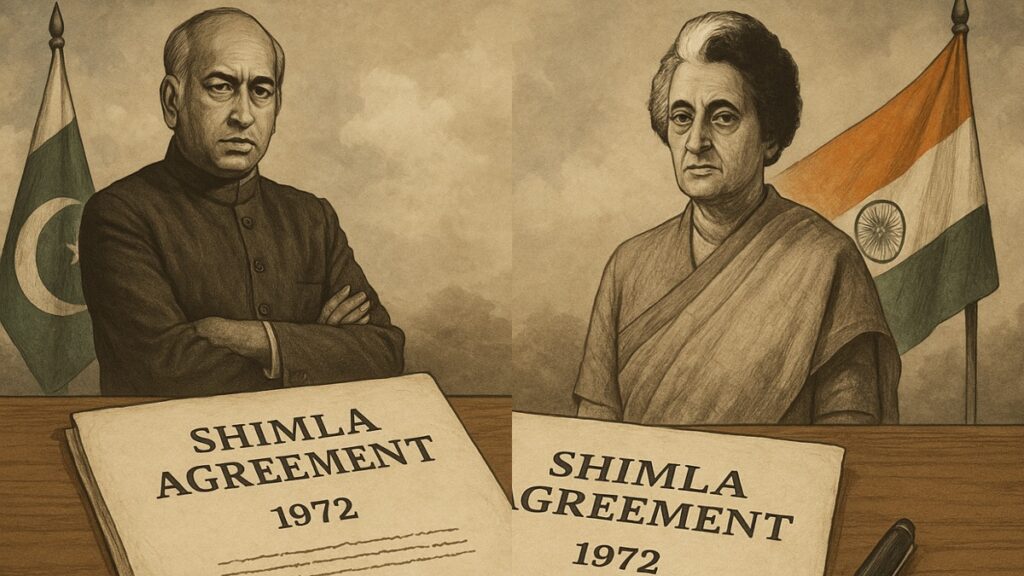Shimla Agreement 1972: On July 2, 1972, a treaty was signed between India and Pakistan in Shimla, which is the capital of Himachal Pradesh, an Indian state. This treaty followed the Indo-Pakistan war of 1971, which started after India intervened in East Pakistan as an ally of Mukti Bahini, who were fighting against the Pakistani army in the Bangladesh Liberation War.
Read More: Indus Water Treaty Suspended After Pahalgam Terror Attack: What it means for the Jhelum, Ravi, and Beyond: Shimla Agreement 1972: From Peace Treaty to Modern-Day TensionsThe treaty aimed to end the war and hostilities between India and Pakistan while also promoting better relations and normalisation of ties. During the war, the Indian Army seized over 13,000 km² of land from Pakistan. However, under the treaty, most of this land was returned, with India retaining approximately 883 km², including areas such as Turtuk, Dhothang, Tyakshi, and the Chorbat Valley.
However, in recent times, Pakistan suspended the agreement in response to India’s abeyance of the Indus water treaty after Pakistan’s alleged involvement in the 2025 Pahalgam terrorist attack in Kashmir.
What is the Shimla Agreement?
After the Indo-Pakistan war in 1971, Pakistan was invited for a Shimla table meeting, in which both nations’ heads, including Indira Gandhi and the president of Pakistan, Zulfiqar Ali Bhutto, signed a paper. The agreement paved the way for diplomatic recognition of Bangladesh by Pakistan. This agreement was penned down at 00:40 hours on the night of 3 July despite the official documentation dated 2 July 1972.
Major Outcomes of the Shimla Agreement
In this meeting, both countries had landed on several major outcomes.
Kashmir, a bilateral matter
They settle their differences by peaceful means through bilateral negotiations. The Kashmir dispute has been a contentious issue since 1947. During this meeting, both sides have agreed that the Kashmir dispute is a bilateral matter that should be resolved through bilateral negotiations. The Shimla Agreement, 1972, denied third-party intervention on Kashmir issues, even that of the United Nations.
Read More: Pahalgam Attack: Pakistani Terror Groups Conducted Rece Before Strike, 28 killed in Kashmir’s deadliest attack: Shimla Agreement 1972: From Peace Treaty to Modern-Day TensionsCreation of Line of Control
In the meeting, the Line of Control (LOC) and the ceasefire line had been decided between India and Pakistan, and it was agreed that neither side shall seek to alter it unilaterally, irrespective of mutual differences and legal interpretations. Later on, the United Nations Military Observer Group in India and Pakistan (UNMOGIP) was formed to monitor the ceasefire line in the Karachi agreement of 1949, which no longer exists. Pakistan has a different take on these issues, and both countries still host the UN mission.
Recognition of Bangladesh
The Shimla Agreement was officially signed by India and Pakistan, which resulted in the recognition of Bangladesh as the nation.
Suspension of Simla Agreement
Recently, after the Pahalgam terrorist attack in Kashmir, India decided to put the Indus Waters Treaty in abeyance. In response, Pakistan suspended the Shimla Agreement 1972, stating Indus water suspension as the act of war.
Read More: Terrorist Attack in Kashmir: Terrorists open fire on tourists in Pahalgam, Home Minister to visit J&K: Shimla Agreement 1972: From Peace Treaty to Modern-Day TensionsThe impact of the dispute became evident when both Indian and Pakistan closed their airspace to each other. As a result, Indian flights from northern India took longer to reach Middle Eastern countries, leading to an additional expenditure of approximately Rs 77 crore per week.


